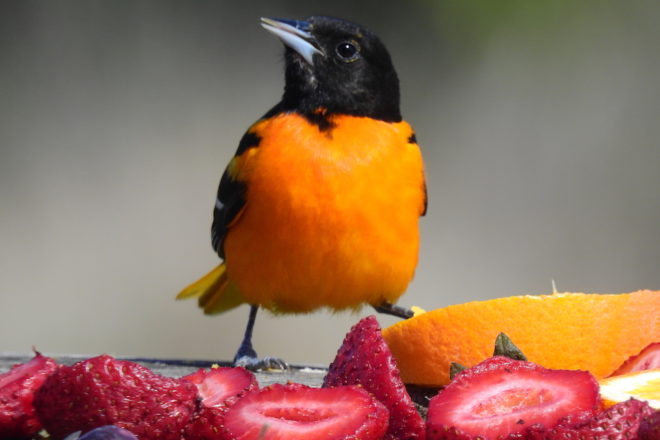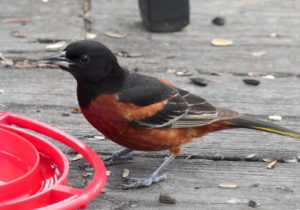Colorful Migrants Finally Wing Their Way to Peninsula
- Share
- Tweet
- Pin
- Share

Some of the most beautiful birds in North America are winging their way to and through the Kewaunee/Door County peninsula this week.

An orchard oriole found little sugar water left early one morning after raccoons ransacked the hanging feeders. Photo by Kevin Naze.
The first-of-year Baltimore orioles, rose-breasted grosbeaks and ruby-throated hummingbirds are here, and a lucky few bird watchers have seen (or may soon see) orchard orioles, indigo buntings, eastern towhees and scarlet tanagers.
If you want a shot at attracting these and other colorful visitors, now’s the time to clean feeders and stock them with fresh seeds, suet and sweets.
Sliced oranges, grape jelly and sugar-water solutions are best for orioles and hummingbirds. Oranges are very attractive early on, but fresh grape jelly can keep orioles around longer.
For sugar water, there’s no need to buy pre-packaged mixes. Simply use one part sugar to four parts water; shake well to fully blend; and pour into the feeder. Clear liquid is fine. Although there’s no research to confirm this, it’s possible that some dyes used in prepared mixes might not be healthy for the birds.

Gray catbirds are fun to listen to and can be attracted with raisins or a variety of fresh fruit. Photo by Kevin Naze.
Because orioles and hummingbirds prefer different sizes of perches and ports, use at least one feeder that’s recommended for each species. Rose-breasted grosbeaks enjoy sunflower and safflower seeds, and fruits. One year they devoured bananas I put out; last year, not so much. A mix of blueberries, grapes, raisins and strawberries works for catbirds, robins, house finches and many other species. “When in doubt, try it out” is my motto for using various fruits. You’ll be surprised at how many species take a taste.
Indigo buntings will eat the same nyjer thistle that goldfinches like. If the finches haven’t been touching yours, it’s time to dump it and start with a fresh batch. I buy nyjer in small bags to make sure it is fresh.
Bluebirds love mealworms, but they will also eat soft pieces of fruit, sunflower hearts and suet.
A bird bath or other water feature is a great attraction, especially during dry spells. Just like with feeders, wash and rinse it often for the best results.
There are dozens of other species that will be resting and foraging for tiny insects while migrating farther north. Colorful warblers and others are best seen with binoculars and spotting scopes in state parks and along rural woodland and marsh edges.
Track the latest bird sightings or report your own at ebird.org/wi/home.
Tips for safe boating
America’s maritime first responder, the U.S. Coast Guard, reminds boaters that cold water kills. Anyone who’s out recreating should dress for the water, not the weather, and wear a personal flotation device.
Boaters should check the forecast before heading out and let someone on land know their plans. Life jackets work only when they’re worn, so buckle up.
“Coasties” around the Great Lakes have been busy redeploying buoys for the season. You can track real-time observations or watch for trends in wind speed, water temperature, air temperature and wave height at glbuoys.glos.us.
For more tips on staying safe this season, visit the Coast Guard’s Great Lakes page on Facebook or Twitter, or news.uscg.mil.
On another note – pun intended – the U.S. Coast Guard Band is performing three concerts in Wisconsin this year, including Aug. 9 at the Southern Door Community Auditorium.
Wausau and Milwaukee, plus Marquette, Michigan, are among the other stops on a 13-performance tour around the Great Lakes.
Wisconsin gets $31 million
The U.S. Fish and Wildlife Service is releasing $31.4 million to the Wisconsin DNR as part of a return on the annual distribution of excise taxes on boat fuel and fishing, hunting and shooting equipment.
Funds are reallocated to the states based on land and water area and the number of paid hunting and fishing license holders.
Wisconsin is slated to receive $19,739,356 in wildlife funds and $11,703,306 in sport fish restoration money. The DNR uses it for things such as habitat work, research, hunter education and increasing public access through land purchases and boat-launch or shooting-range improvements.
According to the DNR, hunting contributes about $2.5 billion to the Wisconsin economy each year, fishing about $2.3 billion and boating about $1.2 billion.
WWOA celebrating 40th year
As part of celebrating its 40th anniversary, the Wisconsin Woodland Owners Association (WWOA) is offering more than a dozen Open Woods events across the state May 18 and invites private-woodland owners to take a closer look at what the group does at wisconsinwoodlands.org.
Fishing tournaments in Door County
Check out trophy bass, learn from seasoned anglers or take the kids for some fun at a pair of Door County bass tournaments the next two weekends. See the schedule at sturgeonbaybasstournament.com and sbobt.org.
NestWatch returns in 2019
Anyone who finds a bird’s nest can participate in a free citizen-science project. Learn more at NestWatch.org, or download the app to your Apple or Android device.


